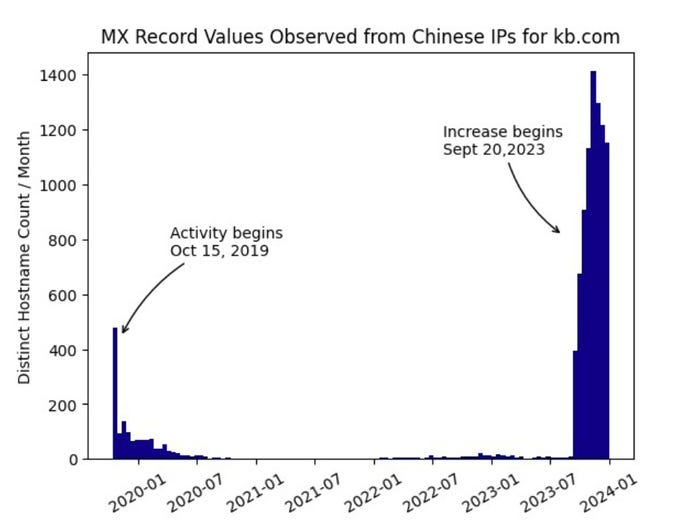
Breaking cybersecurity news, news analysis, commentary, and other content from around the world, with an initial focus on the Middle East & Africa and the Asia Pacific
'Muddling Meerkat' Poses Nation-State DNS Mystery'Muddling Meerkat' Poses Nation-State DNS Mystery
Likely China-linked adversary has blanketed the Internet with DNS mail requests over the past five years via open resolvers, furthering Great Firewall of China ambitions. But the exact nature of its activity is unclear.
April 29, 2024

During an investigation into the activities of a threat group providing domain name system (DNS) infrastructure for illicit online gambling sites, threat researcher Renée Burton discovered something completely novel: Covert traffic immune to China's government-run firewall using open DNS resolvers and mail records to communicate.
The China-linked group — dubbed Muddling Meerkat — has demonstrated its ability to get specific DNS packets through the Great Firewall, one of the technologies separating China's Internet from the rest of the world, Burton, vice president of threat research at network security firm Infoblox, wrote in an analysis published this week.
While most requests for restricted domains return a seemingly random IP address, Muddling Meerkat is able to get DNS mail (MX) records with random-looking prefixes in response to certain requests, even when the domain has no mail service.
The goal of the capability remains unclear — most likely it's for reconnaissance or establishing the foundations of a DNS denial-of-service attack, Burton says — but the demonstrated expertise and ability to pierce the GFW deserves additional research, she says.
"We have a deliberate, very cunning use using very detailed knowledge of DNS — this is not your average cybercriminal; this is not your average teenager; these people are experts in DNS," Burton says. "So we have something that has been going on for four and a half years at this point, which isn't observable in any one location, but is deliberate and constant — and that combination of things, to me, is worrisome."
The threat research comes as the governments of the United States and other nations have warned that China's military has infiltrated critical infrastructure networks with a goal of pre-positioning their cyber operators for potential future conflicts. While many threat researchers have noted China-linked hacking groups' expertise in finding and exploiting zero-days in edge devices such as firewalls and virtual private network (VPN) appliances, the current research underscores their capabilities in utilizing the domain name system (DNS) for their own purposes.
Great Chinese Firewall: "Operator on the Side"
The Chinese Communist Party prevents its citizens from going to content that the government considers inappropriate or illegal — not by blocking the traffic, but by returning fake responses to DNS queries that prevent a user in China from connecting to the desired site. The approach, dubbed the Great Firewall (GFW), is not an inline traffic filter nor a platform that alters DNS responses on the fly, but rather an "operator on the side" that issues a response that competes with any packet from the original intended destination, says Burton.
While the Great Firewall does not intercept traffic, China does operate another system — often referred to as the Great Cannon (GC) — that takes the adversary-in-the-middle (AitM) approach, modifying packets en route to their destination, she wrote in the report.
"In combination, the GFW and GC create a lot of noise and misleading data that can hinder investigations into anomalous behavior in DNS," the report said. "Muddling Meerkat operations are complex and demonstrate that the actor has a strong understanding of DNS, as well as internet savvy."

Mail (MX) records from kb.com, even though the domain has no mail service. Source: Infoblox
Typically, researchers can see the Great Firewall in operation. When they send a DNS request to a domain considered to be out of bounds by the Chinese government, the GFW will return a seemingly random IP address. When they ask for a non-existent service for that domain, such as a mail (MX) record, the GFW still sends an IP address. However, Infoblox researchers and their industry partners instead saw mail records for domains that had no mail services, and each MX records had a seemingly random, albeit short, host name.
Kb.com, for example, has no MX records, but the researchers have seen a large number of mail responses, seemingly from the domain for servers with names such as "pq5bo[.]kb[.]com" and "uff0h[.]kb[.]com".
Covert Widespread DNS Traffic
The unexplained Internet traffic — which was initially detected as far back as Oct. 15, 2019 — could be some sort of reconnaissance that uses open resolvers and "super-aged" domains that foil many DNS block lists, says Burton.
"It's super under the radar, right? So that's kind of a recon-y looking thing," she says. "The other thing about it, though, is it has that DNS denial-of-service aspect. There are concerns that the Chinese are positioning themselves for operations against critical infrastructure, and here they've positioned themselves in DNS in a really weird way."
Combined with the recent announcement by the US Cybersecurity and Infrastructure Security Agency (CISA) that China is pre-positioning itself inside other organizations' infrastructures, Infoblox decide to go public with what the company and its anonymous partners had discovered.
Infoblox collaborated with other organizations, which the company declined to name due to worries of retribution and the potential loss of access to the DNS activity data. While the Muddling Meerkat operation appears similar to some "slow drip" DNS denial-of-service attacks, determining the purpose of the traffic will likely require more research participants, Burton says.
"I don't believe there's anyone who can see this operation in totality," she says. "Every single piece is seen individually, and then what we did was we brought a bunch of different pieces together, so we could see the whole thing. This is a complete mystery ... but it definitely is there."
About the Author
You May Also Like



_Nils_Ackermann_Alamy_Stock_Vector_.jpg?width=700&auto=webp&quality=80&disable=upscale)
